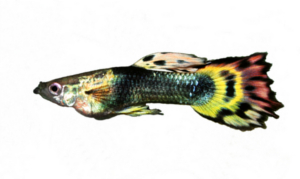

Guppies are one of the easiest tropical fish to breed and care for. Remarkably hardy and breathtakingly beautiful, these little fish do require some specialized care to grow and thrive.
Plain Versus Fancy
There is little difference between the care of plain and fancy guppies. Plain guppies are less brilliantly colored and have smaller fins than their fancy counterparts, but both require the same water quality and feeding. If you have both types of guppies, keep the males separated from the females so you don't inadvertently have a fancy guppy breed with a plain guppy and produce lower quality fry.
Water Quality
Guppies need excellent water quality in their aquariums, or they will become stressed. Plan to change 20 percent of the water each week using a siphon hose. You can pick this up wherever you buy aquarium supplies. Keep the pH of the water in guppy fish tanks between 6.8 and 7.6 to avoid stressing the fish. Use quality aquarium filters and aquarium pumps to keep the water aerated and remove toxins. Aquatic plants, as opposed to fake aquarium decorations, will help with the water quality.
Food
Guppies thrive with some live food supplemented into their diet. Baby brine shrimp, which you can easily hatch at home, are an excellent source of live food. Keep in mind that your fish will also need some commercially prepared fish food to supply their carbohydrate needs, because brine shrimp is mostly protein.
Feed your guppies around three times a day, or more if there are babies in the tank. If you do not feed the parent fish often enough, they will feed on the fry. Also, the babies need frequent feedings in order to grow and develop. Give the fish only the amount they will eat in two minutes.
Breeding
If you keep males and females in the same aquarium, they will breed often. The mother will incubate the eggs inside her body and deliver live babies after about a month of incubation time. A single female can have up to 50 fry in one delivery. If you do nothing, most of the fry will be eaten by the parent fish. If you wish to grow the babies, you will want to invest in a breeding trap. To keep the colors pure, consider separating the males and females, and only putting them together in carefully chosen breeding pairs.